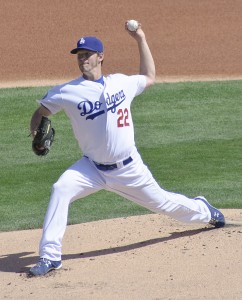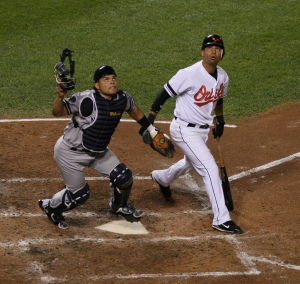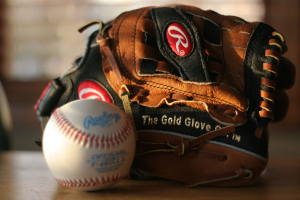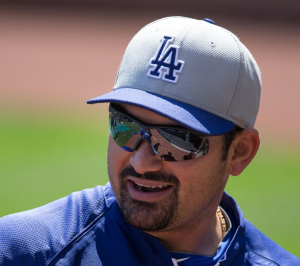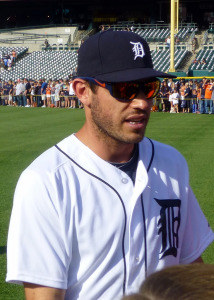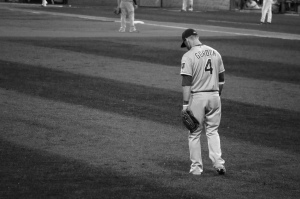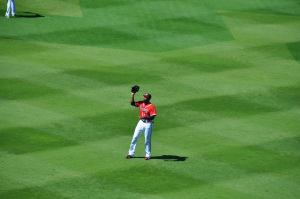Russell Loris “Buzz” Arlett made his major league debut (for the Phillies) on Opening Day (April 14) 1931 – and he made the most of it. A 32-year-old rookie, with 13 minor-league seasons (the first five as a pitcher) under his belt, Arlett started in right field, batting sixth. He went two-for-four, with a double and a run scored. He went on to play in 121 games (RF/1B) that season, hitting .313, with 18 home runs (fourth in the NL) and 72 RBI. Despite showing this promise, Arlett was back in the minor leagues in 1932, where he remained for six more seasons before leaving the professional ranks.
So, why did I choose to dedicate this BBRT post to Buzz Arlett? The decision was based on his minor-league accomplishments, but also influenced by my current geography.
First, his minor-league accomplishments. While Arlett made a pretty good “splash” in his lone MLB season, he was a big fish in a small pond in the minor leagues – as a pitcher and a hitter. In fact, baseball pundits (including sabermetrics guru Bill James) have labeled Arlett the Babe Ruth of the minor leagues.
- As a pitcher, Buzz Arlett picked up 106 minor league wins – and, while at the top of his game (1919-1922), he went 95-71 for the Oakland Oaks of the Pacific Coast League. His best PCL season on the mound was 1920, when he pitched a league-leading 427 1/3 innings, won a league-high 29 games (17 losses), and notched a 2.86 ERA.
- When Arlett’s strong right arm succumbed to overwork, he switched to the outfield/first base. In his first season as primarily a position player, Arlett hit .330, with 19 home runs and 101 RBI. He went on to hit .341, with 432 home runs and 1,786 RBIs in his minor-league career. His 432 home runs were the U.S. minor-league record, until passed by Mike Hessman in 2015. Hessman finished with 433 long balls in 19 minor-league seasons. (The non-MLB record belongs to Hector Espino, who hit 484 home runs in the Mexican leagues).
In 1984, the Society for American Baseball Research named Arlett (already a member of the Pacific Coast League Hall of Fame) the “All-Time Greatest Minor League Player.”
Then, there is the influence of geography. BBRT calls Minnesota home and Arlett’s Minnesota ties piqued my interest. Arlett spent three seasons at the end of his playing career with the American Association’s Minneapolis Millers – hitting .334, with 81 home runs and 285 RBI in 312 games. Arlett joined the Millers in late May of 1934, coming over from the Birmingham Barons of the Southern Association, yet still managed to league the American Association in home runs with 41, while hitting .319 with 132 RBI in 166 games. The following season, at the age of 36, he hit .360, with 25 home runs and 101 RBI in 122 games for the Minneapolis squad.
After retiring from professional baseball, Arlett (who served as a minor-league manager and major-league scout after his playing days) settled in the Twin Cities (Minneapolis/Saint Paul) and operated a successful restaurant and bar (Arlett’s Place, near Nicolett Park, where he had played for the Millers.) His final resting place is Lakewood Cemetery (Minneapolis).
And the impact of geography goes further. As I noted in my most recent post, I am on a family road trip from Cannon Falls to Davis, California. As I write this I am in Davis – about 2,000 miles from home, but just 18 miles from Arlett’s Elmhurst, California birthplace and 70 miles from Oakland, where Arlett played most of his minor-league career. Seems like serendipity to me.
So, here’s a look at Buzz Arlett’s baseball story.
Russell Loris Arlett was born January 3, 1989 in Elmhurst, California – a Sacramento suburb, which also happened to be about 85 miles from the home of the Oakland Oaks Pacific Coast League (PCL) baseball team. Russell had three brothers and the boys were known to be avid and talented baseball players. His oldest brother Al – eight years Russell’s senior – began playing professionally in 1911, primarily in the Pacific Coast League. In 1918, Al “Pop” Arlett, was playing for the Oakland Oaks and the Arlett family, including 18-year-old Russell, decided to make a family trip and join Al at Spring Training. By this time, the youngest of the Arlett brothers had grown to a strapping (for the times) 6’3”, 185-pounds – and had shown some amateur pitching prowess (his nickname “Buzz” came from his ability to cut through opposing lineups like a buzz saw).
During spring training that year, the Oaks were hit hard by injuries and found themselves short of players for an intra-squad game. Buzz Arlett boldly offered to fill the gap and Oaks’ manager Del Howard decided to give the youngster an unplanned chance to pitch. The kid showed good stuff – earning a few more opportunities spring training and, eventually, a spot on the team.
With Arlett’s signing a PCL legend was about to be born, but it didn’t look that way at first, as Arlett won four and lost nine that first season. In 1919, however, Arlett mastered a devastating spitball (to complement a solid fastball and curve) and came into his own as a pitcher. His record over those four seasons was 95-71, 3.20. Here’s a look at Arlett’s four best seasons as a hurler:
- 1919 … 22-17, 3.00 earned run average
- 1920 … 29-17, 2.89
- 1921 … 19-18, 4.37
- 25-19, 2.77
More important, Arlett tossed 1,468 1/3 innings in 212 games over those four seasons – an average of 367 innings per year. By 1923, his right arm was pretty much worn out, and that season he took the mound in only 28 games, duplicating the 4-9 record of his rookie campaign. Not content to sit on the bench and wait for his arm to recover, Arlett, who had been used as a pinch hitter over the previous five seasons, begged his way into the everyday lineup as an outfielder. Still favoring his lame right arm, the natural right-handed hitter also spent hours in the batting cage developing left-handed hitting skills. (Arlett is considered to be one of – if not the first – power-hitting switch hitters.) In his first primarily “offensive” season, Arlett hit .330, with 19 homers and 101 RBI. That was just the beginning. Consider these offensive stats. As a minor leaguer (19 seasons), Buzz Arlett:
- Hit over .300 twelve times, with a high of .382 for the Pacific Coast League Oakland Oaks in 1926.
- Topped 30 home runs eight times (including two seasons of forty-plus homers and a high of 54 for Baltimore of the International League in 1932).
- Drove in more than 100 runs in a season twelve times, with a high of 189 for the PCL Oakland Oaks in 1929.
- Recorded a 1929 Oakland Oaks’ season of 200 games played, 270 hits, a .374 average, 39 home runs, 189 RBI, 146 runs, 70 doubles and 22 stolen bases.
- Playing for the International League Baltimore Orioles in 1932, Arlett hit four home runs in a single game twice in one season (June 1, July 4). Each game featured three left-handed and one right-handed blast from Arlett’s 44-ounce bat.
- In a July 4, 1932 double header, Arlett hit home runs in the last four at bats of Game One (see above bullet) and another in his first plate appearance of game two – giving him home runs in five consecutive at bats.
So, why did a player with all this talent spend so little time in the major leagues?
Arlett was unfortunate enough to play at time when there was no draft and minor-league teams controlled their own players. Further, the Pacific Coast League (PCL) was considered one of the top – if not the top – regional minor leagues. Quality players, solid attendance figures and a weather-aided long season (sometimes more than 200 games) enabled the PCL to pay major league-level salaries and offer major-league playing conditions. Teams demanded high compensation for top players (who not only won games, but put fans in the seats) and the Oaks were reportedly asking the princely sum (at the time) of $100,000 for Arlett. While Arlett garnered some interest as a pitcher, the fact that he relied heavily on the spitball (banned by MLB in 1920) diminished his value. Further, as interest from MLB teams began to rise, Arlett’s arm problems were also on the rise. Later, Oakland’s high asking price kept the power-hitting Arlett in the minors until – facing a changing major league draft policy, and an aging (and now up to a conservatively estimated 230 pounds) and somewhat-injury prone Arlett – the Oaks sold Arlett to the Phillies before the 1931 season.
Why did Arlett last only one year in the big leagues?
Again, age and injury were taking their toll. That, coupled with the now “larger” Arlett’s reputation (correct or not) as a less than adequate fielder, resulted in his release by the Phillies. The fact that, after being released, Arlett played six more minor-league seasons (actually five, in his final season – for Syracuse of the International League – he logged just four at bats) and hit .337, with 177 home runs and 598 RBI (in 657 games) indicates MLB gave up on Arlett when there was still plenty of lightening left in his bat.
Primary Resources: Baseball-Reference.com; Buzz Arlett SABR bio (by Cort Vitty); Runs, Hits and an ERA – The Pacific Coast League 1903-58, by Paul Zingg and Mark D. Medeiros, University of Illinois Press, 1994; On to Nicollet, by Stew Thornley, Nodin Press, 2000.
This post updated, August 2022.
 Baseball Roundtable is on the Feedspot list of the Top 100 Baseball Blogs. To see the full list, click here.
Baseball Roundtable is on the Feedspot list of the Top 100 Baseball Blogs. To see the full list, click here.
I tweet baseball @DavidBaseballRT
Follow/Like Baseball Roundtable’s Facebook Page here. More baseball commentary; blog post notifications; PRIZES.
Member: Society for American Baseball Research (SABR); The Baseball Reliquary; The Negro Leagues Baseball Museum.


